English
Sentence Structure:
Subject and Predicate
English Sentence Structure
English sentence structure is the basic arrangement of words in sentences. Every sentence includes a subject and a predicate. (It may include more than one.)
The subject tells who or what the sentence is about. Then the verb and the rest of the predicate give information about what the subject does or is.
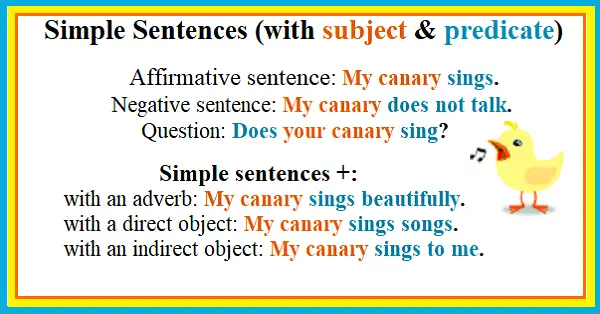
It is possible to have one word sentences in English: a verbal command like “Come!” or “Listen!” In commands, the unexpressed subject of the sentence is ‘you.’
Most English sentences begin with an actual subject. (That's one or more nouns or pronouns, sometimes with supporting adjectives).
After the subject comes a predicate. (That's a verb or verbs sometimes followed by modifiers, phrases, or objects.)
Here are links to the main sections of this page, in case you want to go there directly.
- Types of sentences. (Immediately below this, with links to compound or complex sentence examples.)
- Word order in simple sentences.
- Word order in questions and then negative sentences.
- Phrases
- Direct or indirect objects
- The most important things to remember about English sentences (especially when you write them!)
Types of Sentences
Besides simple sentences, it is possible to have
- a compound subject or verb
- a compound sentence (That means two subject-predicate clauses joined together. For details see Compound Sentences.)
- a complex sentence (two unequal subject-predicate clauses. See Complex Sentences.)
Word Order in Simple Sentences
In these examples, the subject (noun or pronoun + modifiers like adjectives) is orange and the predicate is blue.
Again, the predicate is the rest of the sentence. That always includes a verb. A predicate may also include an adverb, prepositional phrase, or one or more nouns (objects of the verb).
(See the section on direct and indirect objects near the bottom of this page.)
- Birds sing.
- The little birds were singing happily in the treetops.
- Some birds are beautiful.
- Mary walked rapidly to the store.
- She wanted to get home before dark.
- We will study tonight.
- I hope for an ‘A’ on the test tomorrow.
- Tonight, Bill and I need to study hard for the test.
- Jim and Susan do not like homework.
- They won't study.
English Sentence Structure in Questions
In questions the subject (S) follows the helping verb (HV). It is still before the main verb (MV) and the rest of the sentence. So the predicate is divided: HV- S- MV- rest of sentence.
To make the examples clearer, the helping verb is black and the subject is orange. The main verb and rest of the predicate are blue.
- Does Jeff study every night?
- Do Bill and Jeff work together?
- Can you swim?
- Are they swimming right now?
- Is Sarah going to the party?
For more on question formation, see Question Formation.
Structure in Negative Sentences
See also Negative Sentences. (Many negative sentences need helping verbs. Some of the rules for questions apply to negatives as well.) For example:
- Jeff does not (or doesn't) study every night.
- Bill and Jeff do not work together.
- You can't swim.
- They aren't swimming right now.
- Sarah is not going to the party.
Sentence Structure: Phrases
A phrase is a group of words that gives information but is not a complete clause or sentence. (In other words, it does not include both a subject and a verb.)
Prepositional Phrases are groups of words beginning with a preposition. They also include a noun or pronoun (with supporting adjectives, etc.)
In the examples above, ‘in the treetops,’ ‘to the store,’ ‘before dark,’ and ‘for the test tomorrow’ are prepositional phrases.
Direct or Indirect Objects
Predicates can also include direct or indirect objects. The subject does something to the direct object: The boy hit the ball. Mom bought gifts.
Certain verbs can also have an indirect object: The boy gave me the ball. Mom bought us gifts. Indirect objects always precede (go before) direct objects.
Instead of using an indirect object, you could express the same idea with a prepositional phrase. Use ‘to’ or ‘for’ after the direct object: He gave the ball to me. Mom bought gifts for us.
Here are two examples (with explanations):
- University students study subjects in great depth. (‘Subjects’ is the direct object.)
- Some teachers give students a lot of homework. (‘Homework’ is the direct object; ‘students’ is the indirect object.)
Some verbs cannot take direct objects, and other verbs require them. Dictionaries will tell you if a verb is transitive (takes an object), intransitive, or both.
In the first examples above, ’sing’ and ‘study’ are intransitive. But both can also be transitive: we can sing songs or study English. Other verbs like laugh or sleep are always intransitive. They cannot take a direct object at all.
Summary: What You Need to Remember
I hope you don’t feel overwhelmed by all these grammar terms. You don’t need them to speak English. However, understanding English sentence structure can sometimes help with reading or writing.
When you write, it’s important to remember: .
1. Each sentence in English needs a subject and a verb.
2. The subject and verb need to agree. (A 3rd person singular subject must have a 3rd person singular verb. A plural subject needs a plural verb.)
Examples: I am American. You are a student (or you all are students.) He is tired. We like fruit. Mary likes bananas better than apples. Do they need a ride? Does Bob like movies?
See Subject-Verb Agreement for more information.
In questions and negative statements, it’s the helping verb that must agree with the subject. For questions put the helping verb before the subject, and the main verb+ after it. (Does he study English? Do they all study French?
For an explanation of the parts of speech: nouns, pronouns, verbs, prepositions, etc., see English Parts of Speech.
For more complicated English sentence structures, see the pages below.
More on Forming Sentences:
How to form questions in English: a simple explanation with lots of examples using question words and helping verbs.
Compound sentences combine two independent clauses into one sentence. They're not hard with this explanation & a few examples!
Complex sentences combine an independent & a dependent clause to express a more complicated relationship between ideas.
Home> English Grammar Lessons> English Sentence Structure.
Didn't find what you
needed? Explain what you want in the search box below.
(For example, cognates, past tense practice, or 'get along with.') Click to see the related pages on EnglishHints.
| site search by freefind | advanced |
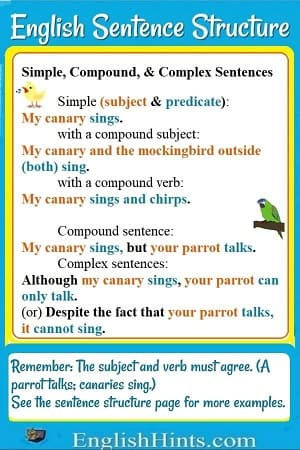
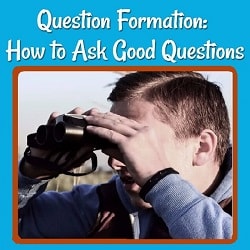
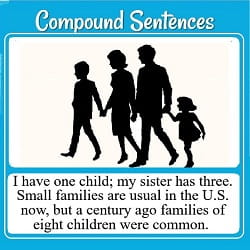
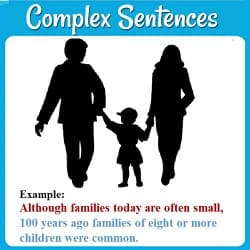




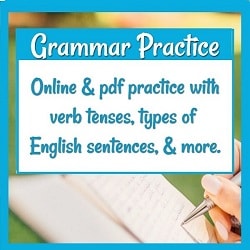



New! Comments
What do you think about what you just read? Leave me a comment in the box below.